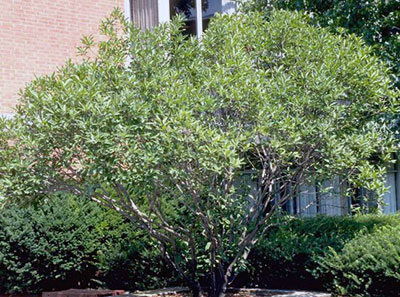Fringetree

A fringetree in summertime, outside Fifield Hall on the University of Florida campus in Gainesville. UF/IFAS, Edward Gilman.
Fringetree, also commonly called Grancy Greybeard and old man's beard, is a small deciduous tree that bursts into bloom in the spring. The flowers are composed of narrow, ribbon-like petals that are snowy white. In fact, the fringetree's botanical name means "snow flower."
Characteristics
There are three species of fringetree that can be grown in Florida: the native white fringetree (Chionanthus virginicus), the native pygmy fringetree (C. pygmeus), and the non-native Chinese fringetree (C. retusus). The white and Chinese fringetrees are widely available, but the pygmy fringetree is endangered. All belong to the family Oleaceae (the olive family), and female fringetrees will produce dark, olive-like fruits that mature in late summer and early fall. While not edible to humans, these fruits are attractive to birds.
Fringetrees are ideal for planting in urban areas due to their pollution tolerance and ability to adapt to a range of soil types. These trees are not ideal for the coast however, as they are not salt tolerant.
Fringetrees lose their leaves in the winter, but in late spring your tree's glossy green leaves will return. Delicate, lightly fragrant white flowers cover these trees for about two weeks during the spring. Native and pygmy fringetrees flower before new leaves emerge in spring, while Chinese fringetree blooms at the end of the spring growth flush.
These trees tend to be slow growing and will usually only reach a mature height of about 20 feet, with up to a 15-foot spread. All three species of fringetree grow well in North and Central Florida.

Fringetree (Chionanthus virginicus) flowers.
Photo: Rebekah D. Wallace, University of Georgia, Bugwood.org
Planting and Care
This tree is generally easy to care for and has few disease or pest problems. If you want your fringetree to really "pop" when it is in bloom, try planting it in a location where the bright white flowers will stand out against a dark background.
Fringetrees prefer moist (even wet), acidic soils, but can also tolerate moderate drought. The tree only experiences a single annual growth spurt, which means it only grows 4-10 inches per year. However, it can be encouraged to grow up to a foot each year with enough fertilizer and irrigation.
Once established, fringetrees do not transplant well, so keep this in mind when you are selecting a planting site for your tree. The foliage will look best when the tree is grown in some shade, but flowering will be most prolific in full sun areas. The ideal location for your fringetree is an area where it will receive sunlight through most of the day and some shade during the afternoon. Make sure the location is also sheltered from wind.
These trees rarely need pruning thanks to a naturally strong branch structure. While your tree is young, you can prune it to a single trunk or a standard multi-trunked form. Once established, these trees require very little maintenance.
For more information on growing fringetrees in your landscape, contact your county Extension office.

A Chinese fringetree in bloom on the UF campus. UF/IFAS, Edward Gilman.

